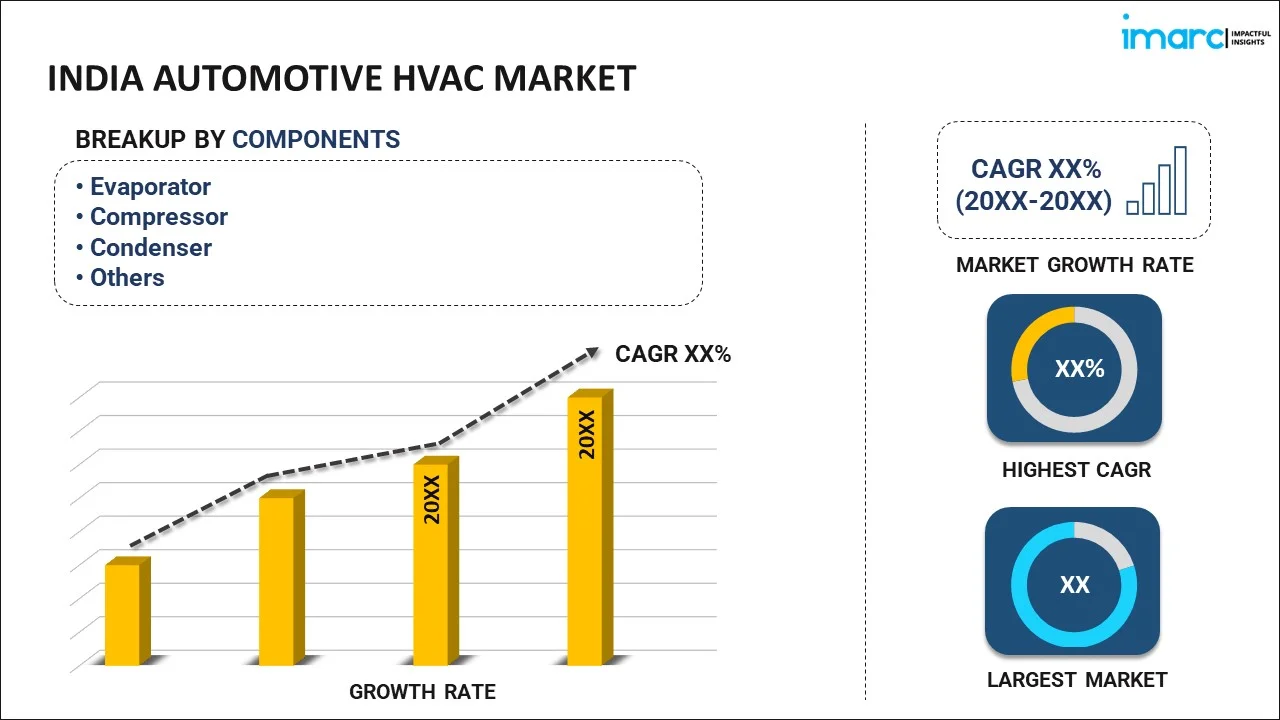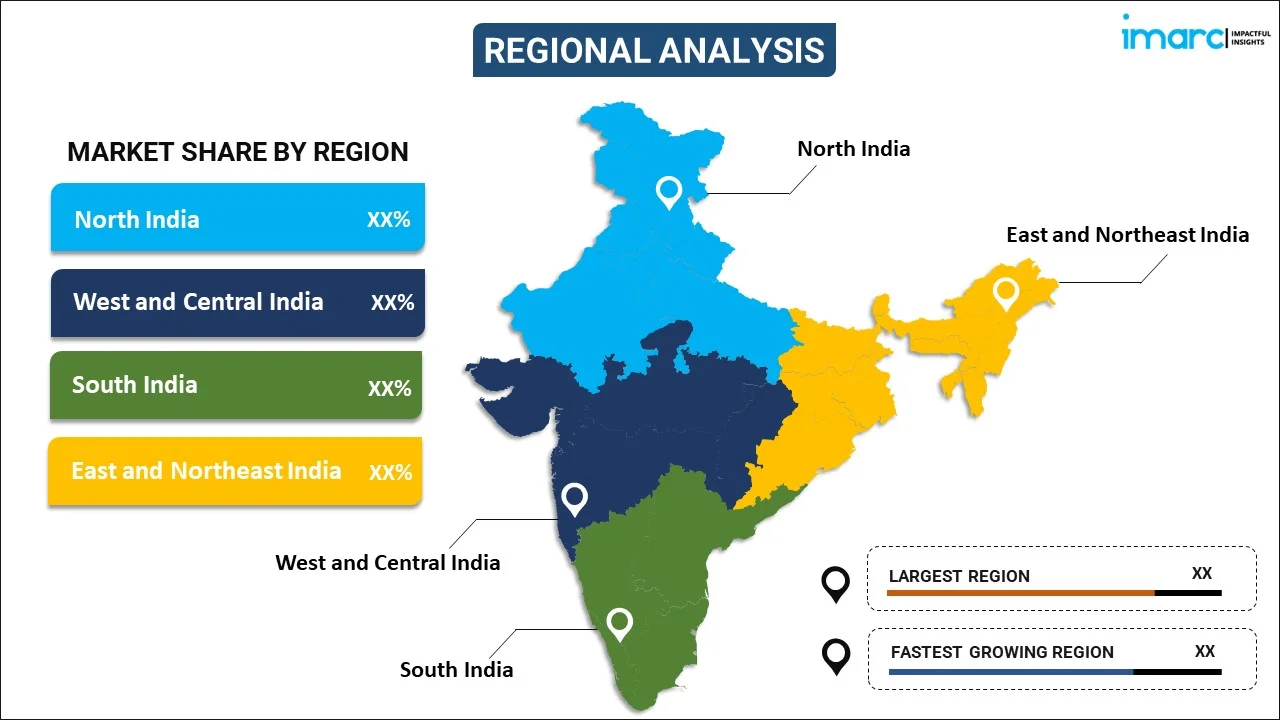
India Automotive HVAC Market Report by Component (Evaporator, Compressor, Condenser, Receiver-drier, Expansion Valve, and Others), Technology (Automatic, Manual), Vehicle Type (Passenger Cars, Commercial Vehicle, Electric Vehicle), and Region 2025-2033
Market Overview:
India automotive HVAC market size is projected to exhibit a growth rate (CAGR) of 10.93% during 2025-2033. The increasing technological advancements, such as smart climate control systems and integration with vehicle connectivity features, which contribute to the demand for sophisticated HVAC solutions, are driving the market.
|
Report Attribute
|
Key Statistics
|
|---|---|
|
Base Year
|
2024 |
|
Forecast Years
|
2025-2033
|
|
Historical Years
|
2019-2024
|
| Market Growth Rate (2025-2033) | 10.93% |
Automotive HVAC (heating, ventilation, and air conditioning) systems are integral components in vehicles designed to regulate the interior climate for optimal comfort. These systems ensure a pleasant driving experience by controlling the temperature, airflow, and humidity within the cabin. During colder weather, the heating function warms the interior, while the air conditioning cools it in hotter conditions. Ventilation maintains fresh air circulation, preventing the buildup of odors and ensuring a healthy environment. Automotive HVAC systems utilize a combination of components such as compressors, condensers, evaporators, and fans to achieve these functions. Advancements in technology have led to more sophisticated climate control features, including automatic temperature adjustment, air filtration, and zone-specific settings. Efficient automotive HVAC not only enhances driver and passenger comfort but also contributes to overall driving safety and well-being.
India Automotive HVAC Market Trends:
The automotive HVAC market in India is experiencing robust growth, driven by several key factors. Firstly, the increasing demand for passenger comfort and convenience has propelled the adoption of advanced HVAC systems in vehicles. As consumers prioritize a more pleasant driving experience, automotive manufacturers are integrating sophisticated HVAC technologies to meet these expectations. Moreover, stringent government regulations aimed at reducing vehicle emissions have led to a growing emphasis on energy-efficient solutions within the automotive industry. HVAC systems play a pivotal role in achieving energy efficiency by optimizing the heating and cooling processes in vehicles. Consequently, automakers are investing in innovative HVAC technologies to enhance fuel efficiency and comply with environmental standards. Furthermore, the rising trend of electric vehicles (EVs) has contributed significantly to the expansion of the automotive HVAC market. EVs, with their unique cooling and heating requirements, necessitate specialized HVAC systems. This has spurred R&D efforts in the automotive sector to create efficient and tailored HVAC solutions for electric vehicles. In conclusion, the automotive HVAC market in India is being propelled by the confluence of factors such as consumer demand for enhanced comfort, regulatory pressures for energy efficiency, and the evolving landscape of electric vehicles.
India Automotive HVAC Market Segmentation:
IMARC Group provides an analysis of the key trends in each segment of the market, along with forecasts at the country level for 2025-2033. Our report has categorized the market based on component, technology, and vehicle type.
Component Insights:

- Evaporator
- Compressor
- Condenser
- Receiver-drier
- Expansion Valve
- Others
The report has provided a detailed breakup and analysis of the market based on the component. This includes evaporator, compressor, condenser, receiver-drier, expansion valve, and others.
Technology Insights:
- Automatic
- Manual
A detailed breakup and analysis of the market based on the technology have also been provided in the report. This includes automatic and manual.
Vehicle Type Insights:
- Passenger Cars
- Commercial Vehicle
- Electric Vehicle
The report has provided a detailed breakup and analysis of the market based on the vehicle type. This includes passenger cars, commercial vehicle, and electric vehicle.
Regional Insights:

- North India
- West and Central India
- South India
- East and Northeast India
The report has also provided a comprehensive analysis of all the major regional markets, which include North India, West and Central India, South India, and East and Northeast India.
Competitive Landscape:
The market research report has also provided a comprehensive analysis of the competitive landscape. Competitive analysis such as market structure, key player positioning, top winning strategies, competitive dashboard, and company evaluation quadrant has been covered in the report. Also, detailed profiles of all major companies have been provided.
India Automotive HVAC Market Report Coverage:
| Report Features | Details |
|---|---|
| Base Year of the Analysis | 2024 |
| Historical Period | 2019-2024 |
| Forecast Period | 2025-2033 |
| Units | Million USD |
| Scope of the Report | Exploration of Historical Trends and Market Outlook, Industry Catalysts and Challenges, Segment-Wise Historical and Future Market Assessment:
|
| Components Covered | Evaporator, Compressor, Condenser, Receiver-drier, Expansion Valve, Others |
| Technologies Covered | Automatic, Manual |
| Vehicle Types Covered | Passenger Cars, Commercial Vehicle, Electric Vehicle |
| Regions Covered | North India, West and Central India, South India, East and Northeast India |
| Customization Scope | 10% Free Customization |
| Post-Sale Analyst Support | 10-12 Weeks |
| Delivery Format | PDF and Excel through Email (We can also provide the editable version of the report in PPT/Word format on special request) |
Key Questions Answered in This Report:
- How has the India automotive HVAC market performed so far and how will it perform in the coming years?
- What has been the impact of COVID-19 on the India automotive HVAC market?
- What is the breakup of the India automotive HVAC market on the basis of component?
- What is the breakup of the India automotive HVAC market on the basis of technology?
- What is the breakup of the India automotive HVAC market on the basis of vehicle type?
- What are the various stages in the value chain of the India automotive HVAC market?
- What are the key driving factors and challenges in the India automotive HVAC?
- What is the structure of the India automotive HVAC market and who are the key players?
- What is the degree of competition in the India automotive HVAC market?
Key Benefits for Stakeholders:
- IMARC’s industry report offers a comprehensive quantitative analysis of various market segments, historical and current market trends, market forecasts, and dynamics of the India automotive HVAC market from 2019-2033.
- The research report provides the latest information on the market drivers, challenges, and opportunities in the India automotive HVAC market.
- Porter's five forces analysis assist stakeholders in assessing the impact of new entrants, competitive rivalry, supplier power, buyer power, and the threat of substitution. It helps stakeholders to analyze the level of competition within the India automotive HVAC industry and its attractiveness.
- Competitive landscape allows stakeholders to understand their competitive environment and provides an insight into the current positions of key players in the market.
Need more help?
- Speak to our experienced analysts for insights on the current market scenarios.
- Include additional segments and countries to customize the report as per your requirement.
- Gain an unparalleled competitive advantage in your domain by understanding how to utilize the report and positively impacting your operations and revenue.
- For further assistance, please connect with our analysts.
 Inquire Before Buying
Inquire Before Buying
 Speak to an Analyst
Speak to an Analyst
 Request Brochure
Request Brochure
 Request Customization
Request Customization




.webp)




.webp)












